Theories, Principles and models in education and Training (pdf)
22 Pages6364 Words53 Views
Added on 2021-01-01
Theories, Principles and models in education and Training (pdf)
Added on 2021-01-01
ShareRelated Documents
Theories, Principles and models
in education and Training
in education and Training
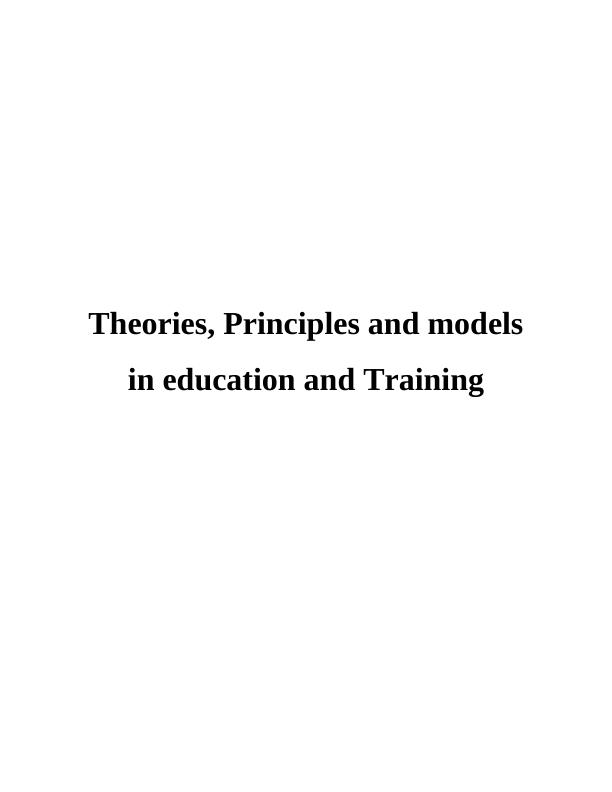
TABLE OF CONTENTS
INTRODUCTION:..........................................................................................................................1
TASK 1............................................................................................................................................1
1.1 Analyse theories, principles and models of learning............................................................1
1.2 Explain ways in which theories, principles and models of learning can be applied in
teaching.......................................................................................................................................2
1.3 Analyze models of learning preferences...............................................................................3
1.4 Explain how learning preferences enables inclusive teaching and learning ........................4
TASK 2............................................................................................................................................5
2.1 Analyse models and theories of communication .................................................................5
2.2 Describe the ways in which models can be applied to learning and teaching assessment ...6
TASK 3............................................................................................................................................6
3.1 Analyze theories, principles and models of assessment........................................................6
3.2 Explain ways in which theories, principles and models of assessment can be applied in
learning........................................................................................................................................8
TASK 4............................................................................................................................................8
4.1 Analyzing theories and models of curriculum......................................................................8
4.2 Applying the theories and models of curriculum..................................................................9
TASK 5..........................................................................................................................................10
5.1 Analyse theories and models of reflection and evaluation..................................................10
5.2 Theories and models of reflection can be applied to reviewing practice............................13
CONCLUSION:.............................................................................................................................13
REFERENCES:.............................................................................................................................14
INTRODUCTION:..........................................................................................................................1
TASK 1............................................................................................................................................1
1.1 Analyse theories, principles and models of learning............................................................1
1.2 Explain ways in which theories, principles and models of learning can be applied in
teaching.......................................................................................................................................2
1.3 Analyze models of learning preferences...............................................................................3
1.4 Explain how learning preferences enables inclusive teaching and learning ........................4
TASK 2............................................................................................................................................5
2.1 Analyse models and theories of communication .................................................................5
2.2 Describe the ways in which models can be applied to learning and teaching assessment ...6
TASK 3............................................................................................................................................6
3.1 Analyze theories, principles and models of assessment........................................................6
3.2 Explain ways in which theories, principles and models of assessment can be applied in
learning........................................................................................................................................8
TASK 4............................................................................................................................................8
4.1 Analyzing theories and models of curriculum......................................................................8
4.2 Applying the theories and models of curriculum..................................................................9
TASK 5..........................................................................................................................................10
5.1 Analyse theories and models of reflection and evaluation..................................................10
5.2 Theories and models of reflection can be applied to reviewing practice............................13
CONCLUSION:.............................................................................................................................13
REFERENCES:.............................................................................................................................14
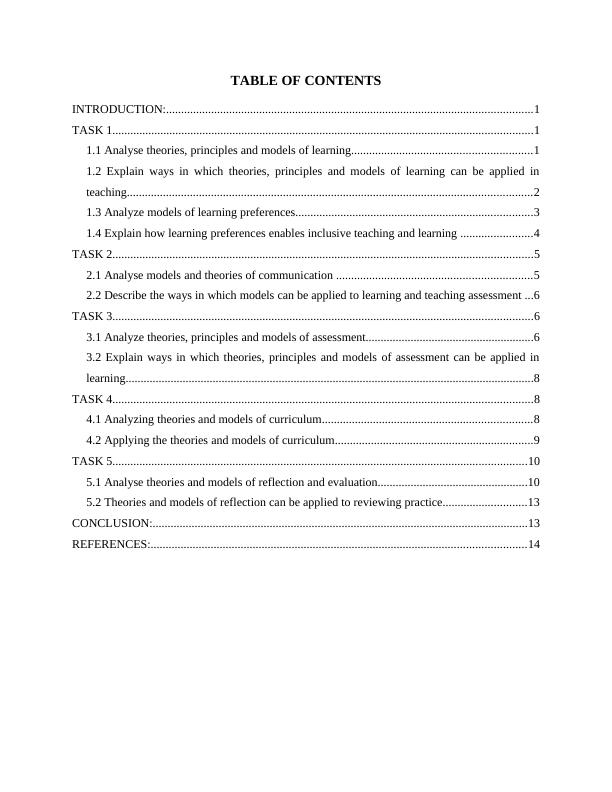
INTRODUCTION:
Education and training helps an individual to learn knowledge and skills. It helps in
career development and growth. It is very important for tutor to evaluate his or her learning so
that it helps in identifying weak areas and improving it (Seaborn and Fels, 2015). Also, it helps
in evaluating his learning by applying different models and theories. Reflecting upon skills show
ho much tutor is able to provide education to students. By using theories individual can enhance
his professional knowledge. There are various models and theories in both education and
training. They are applied in different areas as results differ to a great extent. This report will
describe different models, theories of reflection, communication, curriculum and learning and
how it can be applied in education and training (Kruglanski and Gigerenzer, 2018). Also,
practical examples of them will be studied.
TASK 1
1.1 Analyse theories, principles and models of learning
Principles of learning Organizing efforts: First principle of learning is clear and high expectations for
organizing efforts. Furthermore, it is essential to recognised accomplishment with
curriculum geared to standards. Clear expectations: On the basis of clear expectations, standards are also available which
must be discussed in appropriate way. Moreover, in this regard, intermediate expectations
specified in effective manner.
Fair and credible evaluation: With this aspect, curriculum against absolute standards
must be meet. Reporting systems also makes clear and progressing towards extected
standards.
There are different models and theories through which learning is provided to students.
Also, it is said that student not only learn from education but from other things as well. Tutor
apply various principles to improve their skills. The various theories are described below :-
Education and training helps an individual to learn knowledge and skills. It helps in
career development and growth. It is very important for tutor to evaluate his or her learning so
that it helps in identifying weak areas and improving it (Seaborn and Fels, 2015). Also, it helps
in evaluating his learning by applying different models and theories. Reflecting upon skills show
ho much tutor is able to provide education to students. By using theories individual can enhance
his professional knowledge. There are various models and theories in both education and
training. They are applied in different areas as results differ to a great extent. This report will
describe different models, theories of reflection, communication, curriculum and learning and
how it can be applied in education and training (Kruglanski and Gigerenzer, 2018). Also,
practical examples of them will be studied.
TASK 1
1.1 Analyse theories, principles and models of learning
Principles of learning Organizing efforts: First principle of learning is clear and high expectations for
organizing efforts. Furthermore, it is essential to recognised accomplishment with
curriculum geared to standards. Clear expectations: On the basis of clear expectations, standards are also available which
must be discussed in appropriate way. Moreover, in this regard, intermediate expectations
specified in effective manner.
Fair and credible evaluation: With this aspect, curriculum against absolute standards
must be meet. Reporting systems also makes clear and progressing towards extected
standards.
There are different models and theories through which learning is provided to students.
Also, it is said that student not only learn from education but from other things as well. Tutor
apply various principles to improve their skills. The various theories are described below :-
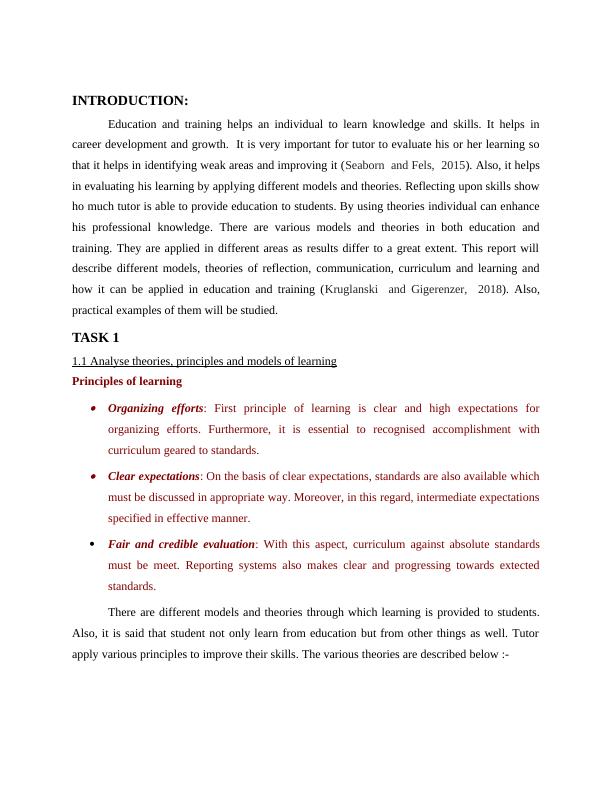
Competency based model :- This model refers to a grading or report system through which
students skills and knowledge are identified. In this it is expected that students learn in order to
progress their education (Baethge and Wolter, 2015). Generally, this model define the
competency in given course which ensure that students acquire the same skills and knowledge
that is necessary for their growth. If students fail then academic report is prepared. This approach
differs from school and university. Each of them develop their own competency model according
to students needs.
Learned based teaching - It is a model in which students solve learn by solving problems,
discussing, providing solutions, etc. It is a form of cooperative learning in which students learn
in teams. In this inductive method is also followed in which challenges are presented to them to
learn something. A learner based model is basically applied in science and engineering.
Constructive approach- it is an approach in which students are shown what they know. Its
purpose is to identify actions through which students solve problem. It helps in reflecting on their
past and present understanding (Simonson, Smaldino and Zvacek, 2014). Tutor role in this is to
suggest students to adopt cognitive strategies such as self learning, reflection, etc. it helps them
to identify weak areas so that it can be improved.
Formal and non formal learning - It is given by following a formal curriculum that is developed
in high schools and universities. These curriculums are guided and recognised by government
and professional teachers. Whereas non formal learning is guided by teachers who are more
experienced. It does not result in diploma or degree.
Behaviourism learning theory – It states that a person learns from surroundings environment. It
means that learning depends on behaviour of that person. The change in respond to stimuli will
change his behaviour (Lackéus and Williams Middleton, 2015). It is divided into two categories
that are classic and operant conditioning.
1.2 Explain ways in which theories, principles and models of learning can be applied in teaching
Theories of learning: Cognitivism: This theory works on the conscious thought, decision making and emotions.
Therefore, it assists to focus on mental processes which is essential to cognitive
students skills and knowledge are identified. In this it is expected that students learn in order to
progress their education (Baethge and Wolter, 2015). Generally, this model define the
competency in given course which ensure that students acquire the same skills and knowledge
that is necessary for their growth. If students fail then academic report is prepared. This approach
differs from school and university. Each of them develop their own competency model according
to students needs.
Learned based teaching - It is a model in which students solve learn by solving problems,
discussing, providing solutions, etc. It is a form of cooperative learning in which students learn
in teams. In this inductive method is also followed in which challenges are presented to them to
learn something. A learner based model is basically applied in science and engineering.
Constructive approach- it is an approach in which students are shown what they know. Its
purpose is to identify actions through which students solve problem. It helps in reflecting on their
past and present understanding (Simonson, Smaldino and Zvacek, 2014). Tutor role in this is to
suggest students to adopt cognitive strategies such as self learning, reflection, etc. it helps them
to identify weak areas so that it can be improved.
Formal and non formal learning - It is given by following a formal curriculum that is developed
in high schools and universities. These curriculums are guided and recognised by government
and professional teachers. Whereas non formal learning is guided by teachers who are more
experienced. It does not result in diploma or degree.
Behaviourism learning theory – It states that a person learns from surroundings environment. It
means that learning depends on behaviour of that person. The change in respond to stimuli will
change his behaviour (Lackéus and Williams Middleton, 2015). It is divided into two categories
that are classic and operant conditioning.
1.2 Explain ways in which theories, principles and models of learning can be applied in teaching
Theories of learning: Cognitivism: This theory works on the conscious thought, decision making and emotions.
Therefore, it assists to focus on mental processes which is essential to cognitive
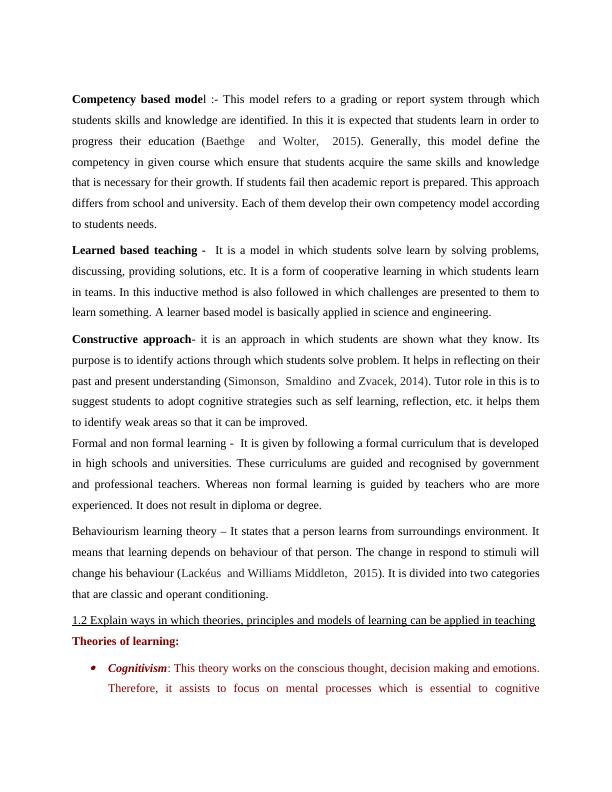
development. It helps to develop new knowledge that align with qualifications that are
process in successful manner. Constructivism: This learning theory emphasis on importance of social influence with
human consciousness. It continuously changing world with ideas to build on the basis of
fellow academics.
Connectivism: It is newer theory of learning. In this regard, more autonomy has been
developed to choose and learn. It is more openness which includes content that how it can
be assessed. Main function of this is that learning environment can be started
successfully.
Principles of learning Prior knowledge that helps or hinder learning: In the course of learning, people must
prior knowledge with belief and attitude. It assists to gain other courses in daily life. It
brings influence to interpret about learning. Motivation determines, direct and sustain to learn: In this regard, connection requires
between pieces of knowledge. Hence, it assists to build knowledge structures that assists
to find accurate and meaningful results.
Goal directed practice: Learning and performance also develop with fostered to engage
people on practices. It also assists to focus on specific goal and criterion. Hence, targets
must be gain at appropriate level of challenge.
Model
The above models can be applied in teaching to generate better outcomes. There are various
ways in which it can be applied that is as follows :-
Individual learning plan- It is a plan that outlines the current ability of students and identifies
future development. It also ensures that students difficulties must lead to effective curriculum as
per their needs. ILP is developed on current skills of students. In this several elements are
considered that are social, economic, cultural, etc. basically, ILP is developed after having a
process in successful manner. Constructivism: This learning theory emphasis on importance of social influence with
human consciousness. It continuously changing world with ideas to build on the basis of
fellow academics.
Connectivism: It is newer theory of learning. In this regard, more autonomy has been
developed to choose and learn. It is more openness which includes content that how it can
be assessed. Main function of this is that learning environment can be started
successfully.
Principles of learning Prior knowledge that helps or hinder learning: In the course of learning, people must
prior knowledge with belief and attitude. It assists to gain other courses in daily life. It
brings influence to interpret about learning. Motivation determines, direct and sustain to learn: In this regard, connection requires
between pieces of knowledge. Hence, it assists to build knowledge structures that assists
to find accurate and meaningful results.
Goal directed practice: Learning and performance also develop with fostered to engage
people on practices. It also assists to focus on specific goal and criterion. Hence, targets
must be gain at appropriate level of challenge.
Model
The above models can be applied in teaching to generate better outcomes. There are various
ways in which it can be applied that is as follows :-
Individual learning plan- It is a plan that outlines the current ability of students and identifies
future development. It also ensures that students difficulties must lead to effective curriculum as
per their needs. ILP is developed on current skills of students. In this several elements are
considered that are social, economic, cultural, etc. basically, ILP is developed after having a
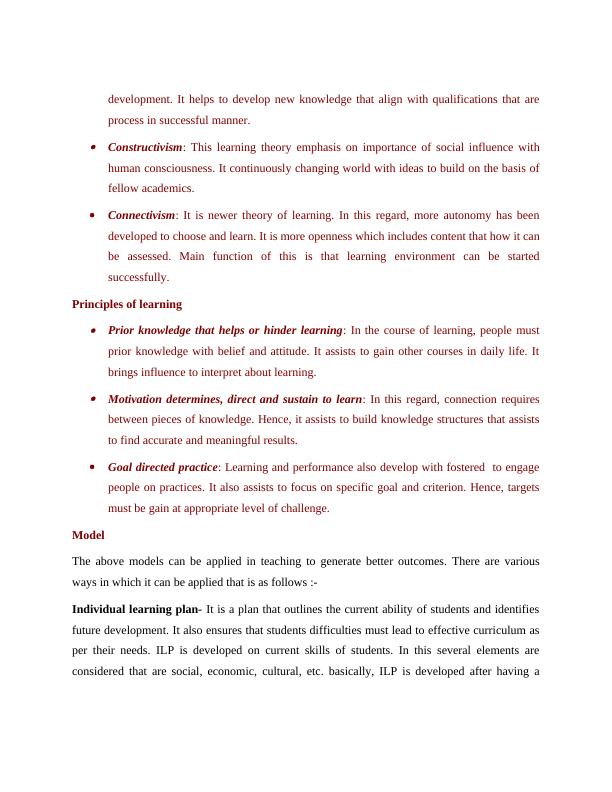
meet with parents, counsellors, etc. (Pekrun and Perry, 2014) ILP must be regularly reviewed, it
must clearly specify responsibilities. An ILP contains several steps :-
Understand needs – first of all identify the needs of students that is their skills,
challenges, etc. this can be done by using questionnaire, interview, etc.
Set SMART goals- In this short and long term goals are set. These goals can be related
to social, academic, etc.
Plan – In this strategies are developed on how goals will be achieved. It includes what
lessons will be taught, when and where it will be taught, etc. also, in this resources are
mentioned that will be required.
Implement – in this plan is implemented by developing schedule.
Monitor – In this plan is monitored. It is seen that whether things are going in right way
or not. What is the progress of students, etc.
Competency based programs- This approach is used by tutors in providing training to students.
Its basic feature is it focuses on training rather than time (Landy and Conte, 2016). This means
that progress is maintained through training. It allows learner to improve their knowledge by
training without wasting time. Skills and competencies of students by done by training rather
than completing the course.
1.3 Analyze models of learning preferences
The different models of learning preference are mentioned below :-
Honey and mumford model – This model is similar to kolb and gibbs, but it can be applied in
better way in education. The four types of people that is described in this model are as follows :-
Pragmatists – these people always tries out new ideas in their practise. This help them to
learn something new. They value new ideas and have practical solution for every
problem. They prefer to implement action quickly by taking effective decision.
Theorists – They collect and gather data from surroundings and then analyse it. This help
them to solve complex situation (Eldredge, Markham and Parcel, 2016).
must clearly specify responsibilities. An ILP contains several steps :-
Understand needs – first of all identify the needs of students that is their skills,
challenges, etc. this can be done by using questionnaire, interview, etc.
Set SMART goals- In this short and long term goals are set. These goals can be related
to social, academic, etc.
Plan – In this strategies are developed on how goals will be achieved. It includes what
lessons will be taught, when and where it will be taught, etc. also, in this resources are
mentioned that will be required.
Implement – in this plan is implemented by developing schedule.
Monitor – In this plan is monitored. It is seen that whether things are going in right way
or not. What is the progress of students, etc.
Competency based programs- This approach is used by tutors in providing training to students.
Its basic feature is it focuses on training rather than time (Landy and Conte, 2016). This means
that progress is maintained through training. It allows learner to improve their knowledge by
training without wasting time. Skills and competencies of students by done by training rather
than completing the course.
1.3 Analyze models of learning preferences
The different models of learning preference are mentioned below :-
Honey and mumford model – This model is similar to kolb and gibbs, but it can be applied in
better way in education. The four types of people that is described in this model are as follows :-
Pragmatists – these people always tries out new ideas in their practise. This help them to
learn something new. They value new ideas and have practical solution for every
problem. They prefer to implement action quickly by taking effective decision.
Theorists – They collect and gather data from surroundings and then analyse it. This help
them to solve complex situation (Eldredge, Markham and Parcel, 2016).
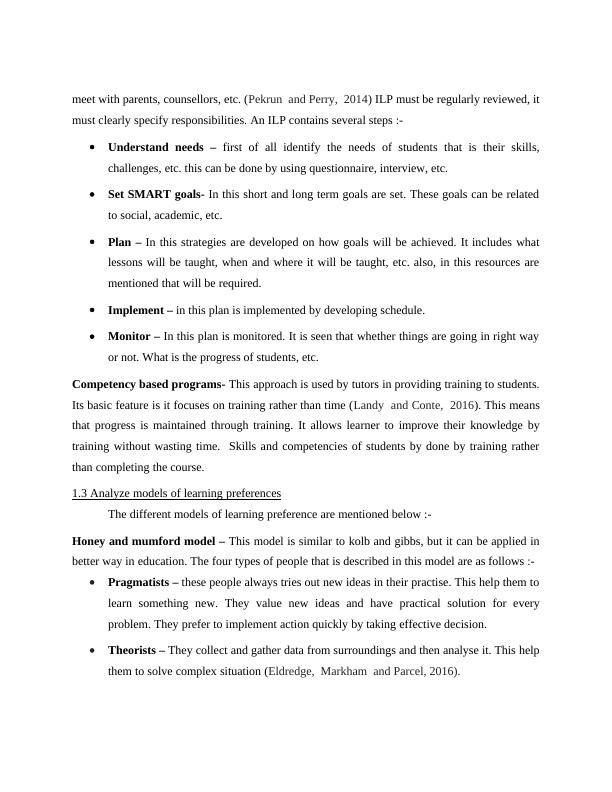
End of preview
Want to access all the pages? Upload your documents or become a member.
Related Documents
Theories Models and Principles in E&Tlg...
|25
|8358
|457
Theories, Principles and Models in Education and Traininglg...
|17
|5899
|85
Theories, principles and models for inspirational teaching and learninglg...
|22
|5383
|456
Theories Principles and Models in Education and Traininglg...
|19
|6385
|98
Theories, Principles and Models in Education and Learninglg...
|30
|9537
|180
Theories, Principles, and Models in Education and Traininglg...
|15
|4946
|81
